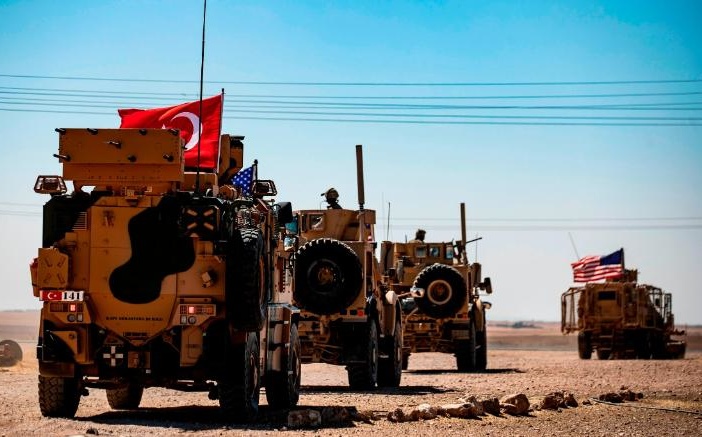A joint Turkish-US patrol in northeast Syria, September 8, 2019
US officials are expressing concern about Turkey’s cross-border military operations into northeast Syria , as the Erdoğan Government declares an imminent end of co-operation with the Americans over a “safe zone”.
The officials used the Wall Street Journal to warn about Ankara’s move into the zone, which extends 480 km (270 miles) along the border, crossing the Euphrates River and extending east to the Iraqi border.
The area, which Turkish President Recep Tayyip Erdoğan said will be 30 km (19 miles) deep, includes the Kurdish cantons of Kobani and Cezire.
Ankara considers the Syrian Kurdistan Democratic Union Party (PYD) and its YPG militia, the leading factions in the Kurdish cantons, as part of the Turkish Kurdish insurgency PKK. But the YPG is the leading element in the US-supported Syrian Democratic Forces, created in autumn 2015 to remove the Islamic State from northeast Syria.
One US official indicated that the American response may not be to confront or deter Turkey, but to withdraw: “It’s a perfect storm, it’s really ugly. There may just be no choice but to leave.”
Last December, Donald Trump, during a phone call with Erdoğan, abruptly decided on the withdrawal of all US troops from Syria. But the Pentagon pushed back against Trump’s order, and about 1,000 American personnel are still in the country. Half are alongside the Syrian Democratic Forces, and half are at the US base at Tanf, in eastern Syria on the Iraq border.
A “person familiar with the matter” said the Trump Administration hasn’t notified Turkey about a possible withdrawal from Syria. He said it could be interpreted as a message to Ankara that it would be worse off dealing alone with the Assad regime and Russia.
Ankara: “Our Plans Are Ready”
Turkey kept up its drumbeat about intervention on Thursday, with Defense Minister Hulusi Akar telling US counterpart Mark Esper by phone that Ankara is determined to end a joint operations room and air and ground patrols if the US stalls on implementation.
After months of talks, Ankara and Washington began the joint operations in early September. However, key details were still unclear and possibly not agreed. These included the depth of the zone — Turkey sought 30 km (19 miles) while the US proposed only 15 km — and operational command of the patrols.
According to the Turkish Defense Ministry, Akar told Esper that the zone must be 30 km deep and said the US must completely halt support for the YPG militia:
Continuing to hold talks, wanting to solve the issue peacefully…should not be viewed as weakness, and saying our plans are ready if necessary should not be seen as a threat.
If there is stalling or delaying, we are fully determined to end this work.
He indicated to reporters that Turkey would carry out the cross-border military intervention if the Americans did not meet Ankara’s demands: “As we have already mentioned before, we have completed our preparations in case of any possibility.”
Foreign Minister Mevlüt Çavuşoğlu echoed, “We think this ongoing process with the United States will not take us to the point we desire. The information coming from the field proves this. We must take steps to clear the terrorist organizations from our vicinity and return refugees there.”
President Erdoğan has said that up to 2 million of the 3.6 million Syrian refugees in Turkey will be resettled in the zone. Most of the displaced are Arabs, raising the possibility of tension with Kurdish groups who have declared autonomy in their cantons.
Erdoğan said Tuesday, “We have not achieved any of the results we desired in the east of the Euphrates [River]. Turkey cannot lose even a single day on this issue. There is no other choice but to act on our own.”
Akar followed on Wednesday, “We are closely following developments in the east of the [River] Euphrates and our army is ready in all aspects. This is not a joke. This should be known and understood by everyone.”
Syria Daily, Oct 2: Turkey’s Erdoğan — We Proceed With “Safe Zone” Without the US
Syria Daily, Oct 3: Turkey’s Defense Minister Points to Military Operations in Northeast


Pentagon spokeswoman, when asked about the WSJ reports and possibility of the withdrawal of the U.S. forces in case of a Turkish operation, said “for security reasons, we are not going to discuss numbers or timelines but as the President has said, a small residual force of the U.S. military will remain in northeast Syria to prevent an ISIS resurgence, and to support stability and security in northeast Syria.”
https://ahvalnews.com/us-turkey/uncoordinated-turkish-military-operation-ne-syria-grave-concern-pentagon 10/3/2019
–
Report warns against U.S. leaving Syria prematurely
A new congressionally mandated report has […] found that drawing down the American military involvement in Syria while protecting U.S. security interests in the region “have proven to be incompatible goals.” “What U.S. forces and their partners have gained in Syria should not be discarded with a premature withdrawal,” the report said.
https://www.washingtontimes.com/news/2019/sep/24/report-warns-against-us-leaving-syria-prematurely/ 9/24/2019
–
Sen. Jeanne Shaheen: The US withdrawal from Syria is foolish, leaving Syria to Russia and Assad causing the biggest humanitarian crisis is wrong, and betraying SDF by turning northeastern Syria into a safe zone under Turkish control means an uncertain future in terms of defeating the Islamic State.
https://www.facebook.com/NPA.SYR/posts/1142581739269730 9/28/2019
–
Syrian Christians Fear a New Genocide In Wake of US Pullout
https://www1.cbn.com/cbnnews/israel/2019/february/syrian-christians-fear-a-new-genocide-in-wake-of-us-pullout 2/1/2019
https://www.youtube.com/watch?v=xy3pTrXnXqs